 |
||
|
||
| ||
The market of Intel processors is so complicated that it is too easy to get entangled here. Let me briefly outline the current situation. So, first comes the high-end segment. Here we have a server version of the Palomino, senior models of the Intel Pentium 4 with RDRAM or soon with DDR SDRAM, i845 or i850. The price is the last thing to count. Now the middle-end sector. Here are only the Intel Pentium 4 and i845. Low-end. We have again the Intel Pentium 4 whose price has recently dropped significantly. The situation with chipsets is not so simple. The i845 is quite dear, and it doesn't seem rational to get a motherboard on it until its modification with DDR SDRAM support is released. There is also an alternative from VIA Technologies which is cheaper and can work with the DDR memory, but the future of the P4X266 is vague as an outcome of the Intel vs. VIA suit is unknown. Of course, VIA fans will buy boards based on it but there are also ordinary users. Besides, many have already bought mainboards on the i815 B-step and they will hardly replace it with the Pentium 4 ones. Taking into account that the Pentium III Coppermine is gradually disappearing with the help of Intel, you may ask what we will have instead of it. Well, there is a Celeron which has changed a bit. It is now based on the Tualatin, the core which attracted many in i815 B-step based boards. The L2 cache is 256 KBytes. But the system bus frequency is limited by 100 MHz as it is still a budget processor. Well, by leaving the L2 cache as it is and reducing the FSB frequency of the Tualatin core for a desktop use Intel launched a "new Celeron". It is exactly that "desktop Tualatin" which was much spoken about when none was sure whether it would be released or Intel would offer only server and mobile versions. Tualatin based processorsThe Tualatin replaced the Coppermine. There are not many changes in the core - it is only the Data Prefetch Logic technology which increased the performance by preliminary loading of required data into cache. Besides, the production technologies are also different - the Coppermine is based on the 0.18 fab process, while the Tualatin is on the 0.13 one. The core power, thus, has reduced considerably: from 1.65..1.75V to 0.9..1.475V. The processor bus voltage has changed from 1.5V to 1.25V. But the key point is a new specification for the VRM - a module on a mainboard which generates core voltage. For the Tualatin the VRM must meets the requirements of the v.8.5. Let's study the differences between the new and old specifications. Since the processors in modern PCs consume huge currents (the Pentium III 1000EB takes up to 20A), it is not easy to built a VRM which would maintain supply voltage at a constant level at a wide range of operating currents. The 8.4 specification set the following parameters: a deviation from the Vcore (set by the processor through the VID outputs) when working in the whole range of currents, and a deviation from the Vcore in case of leaps in current drain. In particular, the permissible spread in voltage values was 15% from the value set by the processor. For a new core with the old technology of the VRM the Vcore would have to keep to a 3% corridor at very high permissible currents - up to 30A! It would be too hard to solve this problem, that is why Intel developed a new VRM specification - v.8.5. Look at the figures below: 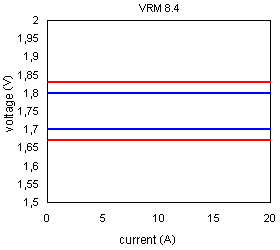 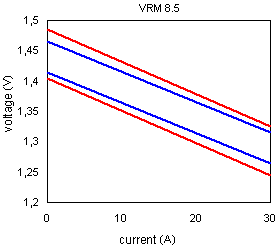 A corridor of the Vcore for a constant load is in blue, and the one for drastic changes is in red. You can see that such term as Vcore has almost disappeared in the VRM 8.5! The Vcore voltage is no more constant. Instead, they suggest plotting a Load Line where the VRM voltage is linearly dependent on the current consumed by the processor. And outputs of the VID processor now set some base Vcore value which defines the deviations of the corridor. According to Intel, this solution is easy to realize and it is more suitable for a 0.13 based core than a constant supply voltage. Apart from the new VRM specification the board must support a new pinout of the processor and be able to work with a 1.25V processor bus. The changes are not great, and universal Coppermine/Tualatin boards are possible. Today we can use, for example, an Intel i815 B-step chipset and chipsets from other companies with the Tualatin support. The BIOS, of course, must also support it. As you can see, the new processor can't be used on old boards because of a new VRM, another bus voltage, pinout etc. Although it can be solved, the price and the performance can turn out to be unattractive. The Tualatin core is currently used in 4 Intel's processors:
 The Celeron is meant for a value market because of a low FSB frequency and a disabled Data Prefetch Logic. But due to the new core these CPUs will work at 1.2 GHz and higher. A processor for desktop PCs (P3P) on the Tualatin core replaces the Pentium III Coppermine. It differs in higher frequencies and in the Data Prefetch Logic support. The maximum working frequnecy today is 1.2 GHz, which is 20% higher than the previous one. 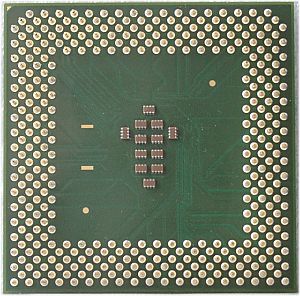 The server processor with the Tualatin has a twice larger cache - 512 KB, and can be used in dual-processor configurations. Obviously, it will be mainly installed in scalable server clusters where it is important to have a low cost and power consumption rather than a high CPU speed. It is expected that this processor will allow creating rack-mount modules of the 1U size which will house up to 4 autonomous systems. Despite the same VRM version with the desktop model these processors are not interchangeable! They differ in power supply requirements. The straight lines on the figure above for the VRM 8.5 refer to the desktop version of the processor. For the server model they have another angle of inclination, and installation of a server CPU into a desktop board will result in a higher Vcore than specified as the load will grow. Since the processor itself can't control the process, it will affect reliability of the system. This difference is reflected in the VRM subversion: v.8.5-5 for desktop systems, v.8.5-3 or servers. Motherboards with support of both processor types are possible, but in this case they must either realize both VRM versions or use a removable module (the VRM specification was created exactly for external modules). The last Tualatin processor is a mobile one. Among its advantages are a high speed and a low power consumption. All variants of the Tualatin processors, except the mobile one, are produced in a FCPGA2 case. It differs from the FCPGA in an Integrated Heat Spreader (IHS). Heat conduction between a core and a cooling device earlier was out of the Intel's control, but it is very important to maintain ta system highly reliable. Let's compare them with the previous models (frequency/FSB/cache/SMP):
On the one hand, the changes are not significant: it is mainly a rise of the clock speed, but the Intel's P6 architecture has successfully taken the 1 GHz hurdle. The transition to the 0.13 fab process was connected with a lot of additional investigations and studies. The new technology, Data Prefetch Logic, the new VRM, and an Integrated Heat Spreader are the required steps to beat the competitors on the dynamic field of microprocessors. TestsTest systems:
Software:
Before we go to the diagrams and test results I'd like to draw your attention to the following issues:
3DMark 2001, total score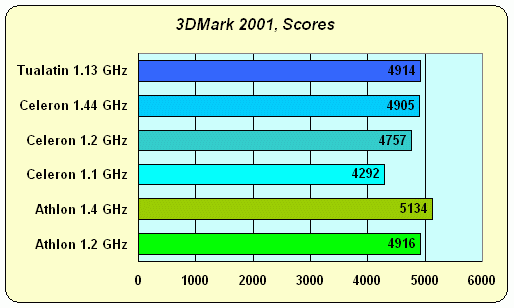 This struggle of different clock speeds, caches, architectures resulted in... nothing. It is only the Celeron 1.1 GHz who obviously loses to all because of its small cache and a low clock speed. All other results can be considered equal with regard to an inaccuracy of measurements. It is clear that the L2 cache size and a FSB frequency play a great role in some applications - the Tualatin at only 1.13 GHz wins from all Celerons. I think that a combination of the FSB frequency and the Data Prefetch Logic is of the greatest importance here. 3DMark 2001, game tests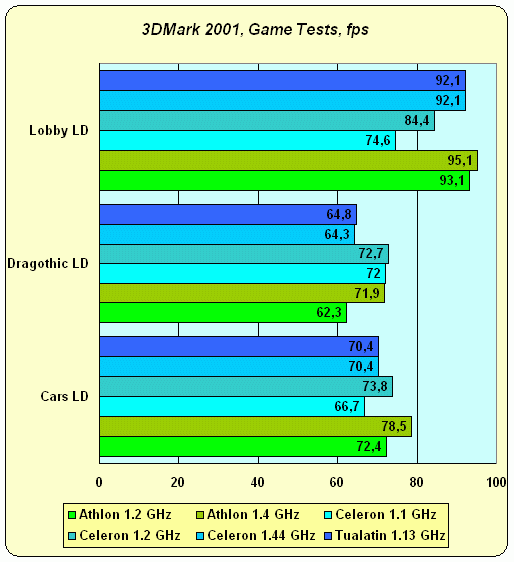 LobbyThe Celeron has a small cache and works at 100 MHz of the FSB but the systems based on it get a stable performance gain. However, this processor can win only at the expense of a too high frequency - the Tualatin 1.13 GHz can be outscored only by the Celeron 1.44 GHz. Both Athlons win, and remember that this CPU has the largest total cache size due to an exclusive L1/L2 architecture. DragothicThe result of this test primarily depends on the frequency and a SSE support. Even the weakest Celeron outdoes the Athlon 1.2 GHz, and the Celeron 1.4 GHz goes on a par with the Athlon 1.4 GHz. The Tualatin comes the last. CarsA FSB frequency and a cache size are the determining factors here. The Athlon thrives again. Quake III The situation is similar to the Lobby and Cars from the 3DMark 2001. The Celeron and Pentium III Tualatin, equal in architecture, clear things up: with the increase in frequency the Celeron gets more efficient, but 100 MHz FSB + 128 KBytes L2 cache is not so beneficial as 133 MHz FSB + 256 KB L2 of the Tualatin. I mean that a 133 MHz FSB would bring much better results than raising of the core frequency. Z&D Winstone 2001 and SYSmark 2001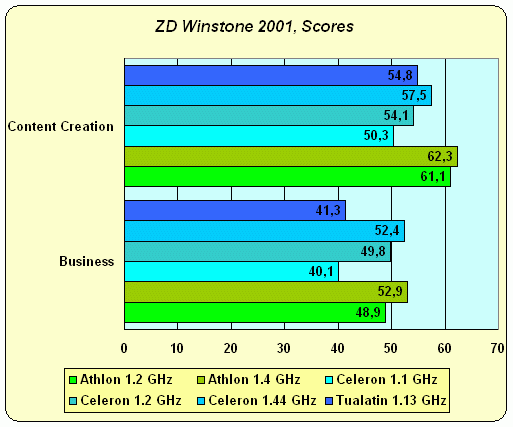 The benchmark from ZD Labs (today's eTesting Labs) prefers the AMD's processor. It is no secret that the Athlon's core is more perfect than a core of the Pentium III / Celeron / Tualatin (at least because it is newer and AMD had enough time to take into account all mistakes of Intel). There are almost no any applications in the Winstone 2001 that would make a profit of possibilities of the Pentium 4. That is why we will leave the Athlon and take a closer look at the Celeron and Tualatin. In business class applications the core frequency matters most of all, while a cache and a FSB speed are not so important (the Tualatin 1.13 GHz is just a little ahead of the Celeron 1.1 GHz and loses to others). On the contrary, when working with graphics and multimedia data a cache and a FSB speed become weightier - it is only the 1.44 GHz Celeron which could outdo the Pentium III Tualatin. It should be noted once more that at the same FSB frequency the Athlon has a greater total cache size. 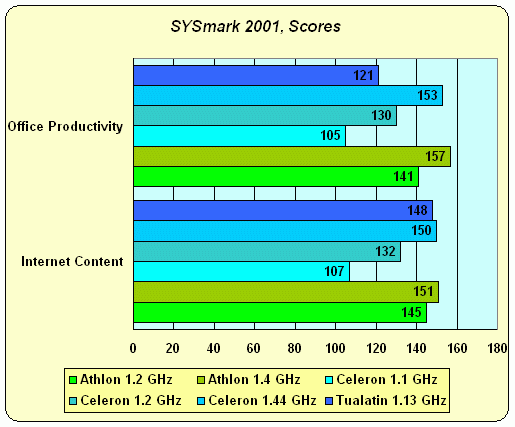 In the SYSmark 2001 the Tualatin feels better in the business applications because BAPCo (SYSmark) and ZD (Winstone) understand differently office applications. For example, BAPCo considers that the Dragon Naturally Speaking program belongs to this class. SPEC ViewPerf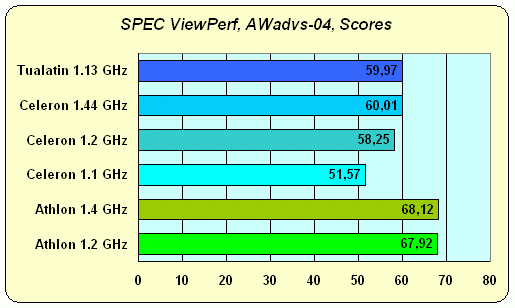 AWadvs-04This test estimates a texturing speed. Starting from a definite frequency the CPU speed stops being important. What matters here is a performance of the memory subsystem. All Intel's processors lose in this test. The Tualatin and Celeron equipped with the PC133 fell behind not because of the processor performance but because of the PC2100 DDR on the Athlons. However, the Athlon with its 266 MHz FSB can use the memory which is beyond the power of the CPUs on the P6 core since the bus bandwidth of the latter is equal to that of the PC133, not more. 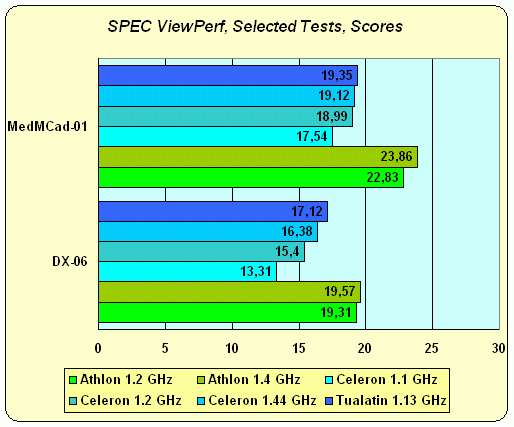 DX-06 and MedMCAD-01The difference between the Intel's processors is evident, and the Tualatin with its huge cache and 133 MHz FSB thrives again - it outscores even the Celeron 1.44 GHz. It is clear that yet the best Celeron hardly suits professional applications. The Tualatin is limited by the memory, and the Athlon becomes a leader. 3DStudio MAX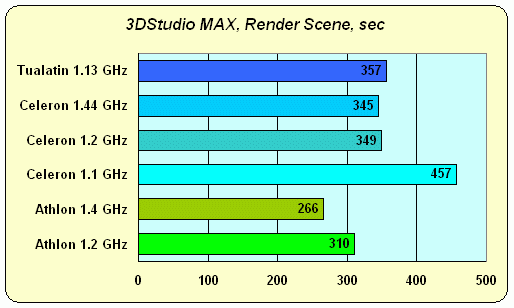 The Tualatin again beats the Celeron in professional applications at the same or a bit lower frequency. On all Socket 370 systems the core frequency is limited by the memory. The further growth of the performance proceed only on the Athlon at the expense of the 2.1 GBytes/sec PC2100 DDR. Expendable and Unreal Tournament  The test of latency was passed by all systems flawlessly (it is only the Pentium 4 + RDRAM which usually fails in the Expendable because of the hardware peculiarities). ConclusionWonders happen more and more rarely in the hardware world. Raise of a core frequency in the 100 MHz (FSB) Celeron series does bring some benefit, but at the threshold of 1.44 GHz it is clear the the performance boost will be smaller and smaller further. In fact, the history of the 66 MHz Celeron repeats: models with the frequency over 667 MHz (a multiplier equal to 10 and more) didn't differ much in performance due to stoppages caused by a difference between the speed of the core and of the memory. But the current Celerons haven't yet reach this threshold and can compete successfully against AMD at an attractive price. The Pentium III Tualatin remains in the high-end
sector, in professional applications even the highest core speed
with a small cache suffers a defeat. That is why the high-efficient
Celeron changed nothing for professionals who prefer an Intel's
platform but who are not in hurry for the Pentium 4.
Write a comment below. No registration needed!
|
Platform · Video · Multimedia · Mobile · Other || About us & Privacy policy · Twitter · Facebook Copyright © Byrds Research & Publishing, Ltd., 1997–2011. All rights reserved. |